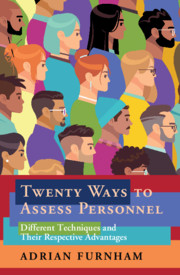Book contents
- Twenty Ways to Assess Personnel
- Twenty Ways to Assess Personnel
- Copyright page
- Dedication
- Contents
- Tables
- Preface
- Acknowledgements
- 1 Introduction to Selection and Assessment
- 2 Complex and Sticky Issues in Assessment and Selection
- 3 Traditional and Mainly Discredited Assessment Methods
- 4 Self-Report Tests
- 5 Observer Reports
- 6 Behavioural Tests
- 7 Physiology
- 8 Biography
- 9 Big Data
- 10 The Future of Assessment
- Index
- References
2 - Complex and Sticky Issues in Assessment and Selection
Published online by Cambridge University Press: 11 June 2021
- Twenty Ways to Assess Personnel
- Twenty Ways to Assess Personnel
- Copyright page
- Dedication
- Contents
- Tables
- Preface
- Acknowledgements
- 1 Introduction to Selection and Assessment
- 2 Complex and Sticky Issues in Assessment and Selection
- 3 Traditional and Mainly Discredited Assessment Methods
- 4 Self-Report Tests
- 5 Observer Reports
- 6 Behavioural Tests
- 7 Physiology
- 8 Biography
- 9 Big Data
- 10 The Future of Assessment
- Index
- References
Summary
The whole process of assessment and job selection is becoming considerably more complicated. There are more choices of methods and great differences in costs. Perhaps one of the hottest topics addressed in this chapter is that of bias, discrimination and fairness. The way an organisation goes about assessment is a matter of PR as candidates and competitors see it as a statement about a company’s philosophy and values. The chapter discusses, as an example, the data which suggest that physically attractive people have undue advantages in the selection process. Assessors and selectors have to become mindful of the perception and reaction of those being assessed, and particularly changes in the law which varies from country to country. The business of selection has to be much more than choosing test methods on fundamental psychometric criteria or economic constraints. Ways of dealing with and reducing bias are considered.
Keywords
- Type
- Chapter
- Information
- Twenty Ways to Assess PersonnelDifferent Techniques and their Respective Advantages, pp. 45 - 74Publisher: Cambridge University PressPrint publication year: 2021



